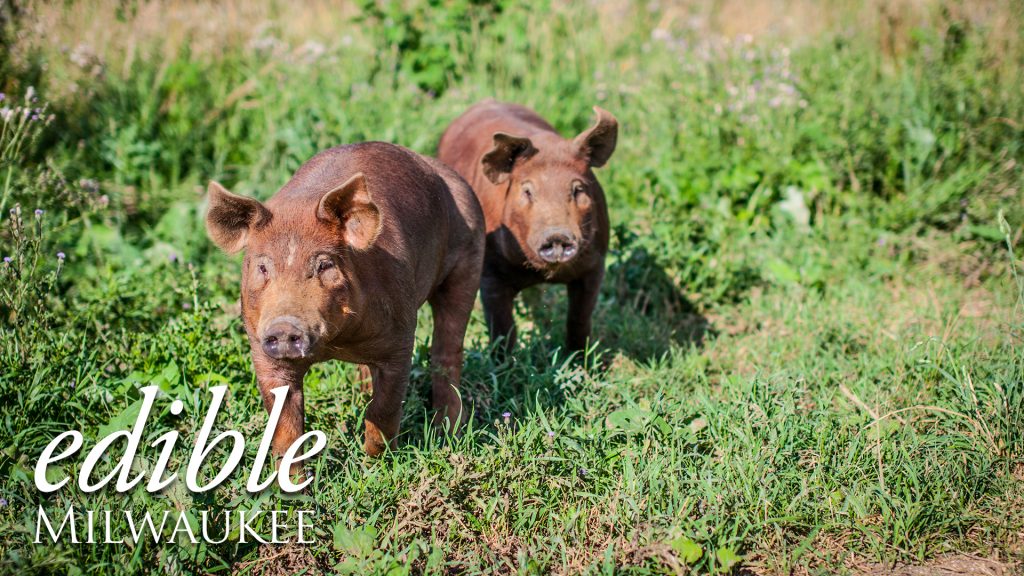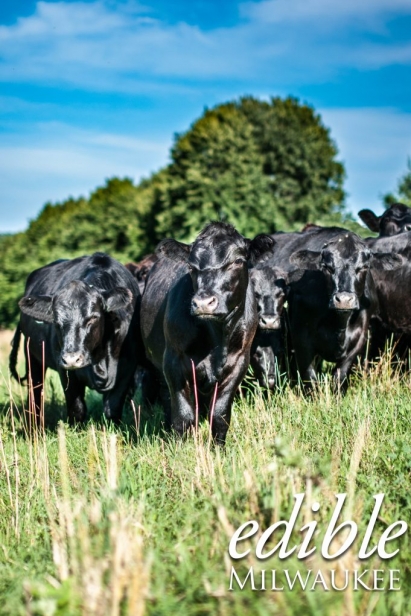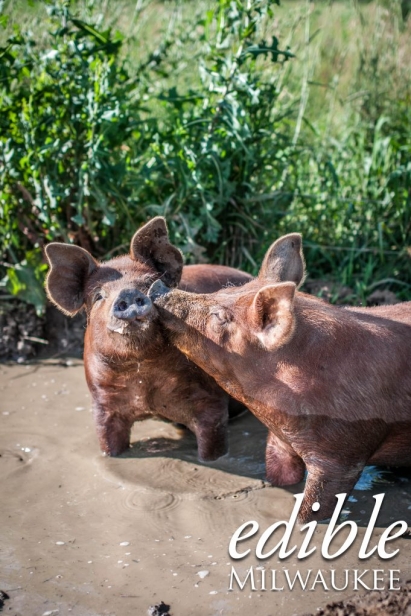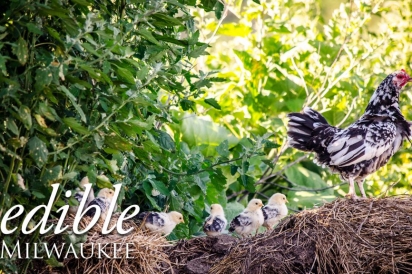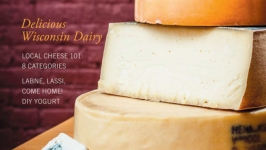Eat Them to Save Them: Farmers Bring Back Heritage Animal Breeds
Pigeon was once a staple of the North American diet.
Enormous flocks of passenger pigeons once darkened the sky, a “feathered tempest,” in the words of conservationist Aldo Leopold, making them an easy target for hunters. In 1871, Milwaukee residents could buy one dozen undressed pigeons for 45 cents or 65 cents per dozen for dressed birds.
But our huge appetite for pigeon had a damning consequence: the extinction of the bird in 1914. We did nearly the same to the buffalo.
But there are other animals that are threatened with extinction not because we eat them too much but because we don’t eat them enough: heritage farm animals.
Extinction isn’t something we typically consider with regard to farm animals. But like many wild animals, diverse domesticated breeds, animals bred over generations, are also threatened with extinction in the United States.
“The saying went, ‘save the best, eat the rest,’” explains Kathy Roxas of Morning Star Farm, of the way animals used to be raised and bred. “The best thing you can do to save these heritage animals now is to eat them.”
“Heritage” has no official meaning for animals. The Livestock Conservancy, an organization that advocates for the preservation of rare and threatened breeds, calls the term heritage one of art rather than a science, though they are working to change that. Heritage breeds, according to the Livestock Conservancy, are pure breeds with a history predating industrial agriculture in the United States. They are the animals you’d have found on your great-great- grandparents’ farm.
Roxas and her husband choose older lines of livestock and poultry when starting Morning Star Farm in Hartford about five years ago. For Roxas, the quality and flavor of the meat were essential.
“The commercial industry is looking for something that looks the same,” says Roxas. “We wanted something that tasted good, so we started with the meats we like to eat.”
Roxas and her family raise cattle, chickens, ducks, pigs and lambs. Preserving these breeds also appealed to Roxas.
“We don’t want to lose these genetics,” says Roxas. “People went to great lengths to raise and care for them.”
Of their pigs, Roxas says they typically have crosses of three heritage breeds: Tamworth, Chester White and Large Black.
The Large Black is a success story, of sorts, in heritage breeds. A pig native to southwestern England, the Large Black was once one of the most common English pig breeds on both sides of the Atlantic. But its popularity peaked in the 1920s and the breed nearly went extinct during the 1960s. Consumer interest in pasture-raised pork in recent years has led to a growth in the number of breeders like Roxas, saving the hog from becoming a statistic.
Morning Star raises two types of heritage sheep. The Dorper/Katahdin-cross lambs are bred on the farm while the Icelandic lambs are born on a friend’s nearby farm and pastured at Morning Star. They are hardy animals as you might expect of animals like the Katahdin lambs with roots in Maine, and Iceland. The Icelandic sheep are particularly well known for their creamy milk, beautiful wool and fine-grained meat.
Figuring out which animals to raise wasn’t as hard as Roxas first thought it might be.
“We learned from other farmers and have really been the beneficiaries of the farmers who came before us,” says Roxas. “That made it much easier to step right in to raising them.”
Livestock were first domesticated 10,000 years ago. Farmers traditionally raised thousands of different animal breeds, all tailor-made, through natural and human selection, to the people and climate in which they lived. These animals typically lived on farms with many other kinds of animals.
But that changed with industrialization and efforts to “improve agriculture” beginning in the late 19th century. Farms grew bigger and endeavored to produce more with less waste to improve profits. Regional variations in breeds were replaced with animals that reproduce faster, could withstand cramped quarters and could produce more meat, more milk and more eggs.
The Livestock Conservancy estimates that one-third of livestock and poultry breeds are rare or declining in North America. Of the more than 250 breeds of beef cattle, less than 20 are raised commercially in the United States.
Today, more than 90 percent of dairy cattle in Wisconsin, like the rest of the nation, are Holsteins, the easy to identify cow with black (and sometimes red) and white markings. The Holstein has become an excellent milk producer but lost much of its fertility, disease resistance, and hardiness in the process of selective breeding for an industrial scale.
Wisconsin may be America’s Dairyland but the number of farms raising beef cattle has grown by 44 percent since 1986. Beef cow breed numbers aren’t kept but Kewaunee County Extension Agent Aerica Bjurstrom with the Wisconsin Beef Information Center says that the most common cow is a commercial crossbred cow consisting of Angus and a mixture of other breeds. Of the purebreds, Angus is the most common.
Heritage animals tend to have a different flavor and sometimes their meat even a different look than mainstream breeds. Heritage breeds are often richer and gamier in flavor with more marbling from the higher fat-to-meat ratio.
It’s that unique flavor that motivated Greg and Jeannie Bull of Bull’s Ranch in Watertown to invest in heritage cattle. The Bulls started with dairy cows but the meat quality wasn’t great and they wanted to go one hundred percent grass fed with their herd. Then they learned about Galloways, a very old and pure breed from the Galloway region of southern Scotland.
“Everyone has black Angus so I liked that these cows were unique and hardy animals with a long history,” says Jeannie Bull.
Galloways have a double coat of hair so they don’t need shelter, though the Bulls provide lean-tos for their animals. The cows also do well on less than ideal hay or pasture, making them a good match for Wisconsin’s climate.
Galloways, like many other heritage breeds, take longer to reach a marketable size. Many commercial operations slaughter their cattle at thirteen months. The Bulls wait at least two years because, according to Jeannie Bull, the older age means bettertasting beef.
“I was very discouraged by our throwaway society,” explains Bull. “The Galloways can live a long time and have calves into their mid-teens so we can sustain our herd for many years.”
Bull came to farming later in life. She grew up in an apartment in Milwaukee but spent her summers on her grandparents’ farm. She always dreamed of having her own farm, and at 35, got her first horse and later, cattle. She says she’s living her dream life.
“I really care about my animals and want them to have a good life,” says Bull. “I also want to preserve these older lines of animals because I think it’s important to preserve what we have.”
Brandon and Tammera Dykema of Dominion Valley Farm in Allenton started their farm with pastured poultry in 1998 and soon added turkeys, ducks, pigs, and cows.
“We did a lot of research and learned quickly how much better animals do on pasture,” explains Tammera Dykema. “And the heritage breeds just do beautifully on pasture. They know how to survive.”
Like Bull, the Dykemas fell in love with Galloway cattle.
“They are smaller so they aren’t as desirable but they have a wonderful flavor and are such docile animals,” says Dykema.
Dominion Valley also raises Tamworth and Large Black hogs, and the Dykemas feel a responsibility to keep these breeds going.
Jeff Preder didn’t start out with heritage breeds. The fifth-generation farmer purchased his family dairy farm to raise Holsteins of his own, intending to follow his family’s path. But in the late 1990s, a friend from Missouri turned him on to Piedmontese cattle, a low-fat, low-cholesterol beef cow. They purchased a few as a trial. One taste of its meat and the Preders swore off Holsteins.
“My wife Kathleen tasted it and said of our Holsteins, ‘never again,’” says Preder. “There was such a difference in taste and quality.”
Piedmontese cattle originated in the Piedmont region of northwest Italy, and were brought to North America in 1979. The cattle are known for being lower in fat and cholesterol than other beef animals because they are double-muscled, a mutation of the myostatin gene that causes the cows to have more muscle mass than conventional cattle. As a result, they are known to produce very lean meat that’s still tender.
Preder raises Piedmontese cattle on pasture year-round at his Random Lake farm named Jeff-Leen, a mash-up of Jeff and Kathleen’s first names. The transition from dairy to beef cows constituted one learning curve. But Preder says it was a much bigger transition to 100-percent grass fed beef.
“We’re still learning how to keep our cows as healthy as possible,” says Preder.
Because of the uniformity of commercial beef, the Preders struggled at first to find a market for their animals.
“Traditional markets didn’t recognize naturally low-fat meat,” says Preder, “because they believed that fat meant flavor. But Piedmontese are known for having tender meat because of their genes.”
The tenderness of Piedmontese beef also comes from the environment. Preder’s cattle are raised under a strict rotational grazing pattern. It takes longer to finish the animals but Preder believes the taste and health of his cows is well worth it.
Chef Jack Kaestner, formerly of the Oconomowoc Lake Club, agreed and helped Preder connect with other local chefs and wholesale markets willing to take a chance on Piedmontese.
Farmers like Roxas, Bull, Dykema, and Preder are doing their part to keep rare breeds alive. They’ve been helped by increased consumer interest in regional foods and a growing appetite for unique flavors. Slow Food Wisconsin Southeast has helped bolster heritage turkeys by publicizing heritage turkey breeders to eaters looking for a unique and delicious Thanksgiving bird.
“The first question people ask me is ‘where are you located?’” says Dykema. “They really want to know that we are local. We welcome visitors to our farm and have an annual open house so people can really see where and how we are raising their food.”
But these heritage breeds are far from safe from extinction without continued farmer and consumer interest in raising and eating them. It’s not the cheapest or fastest way to raise animals, nor the most profitable, but it is satisfying.
“I really love them,” says Bull of her Galloway cattle. “It’s a breed that survived for hundreds of years and I’m doing what I can to make sure they are around for hundreds of years more.”


